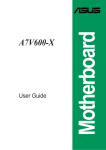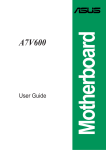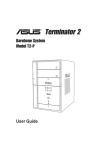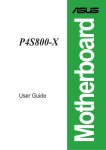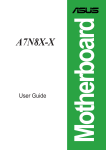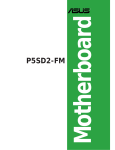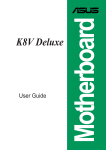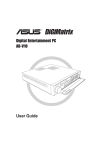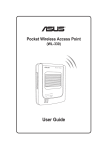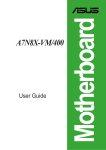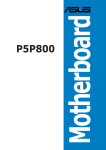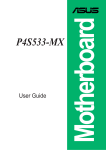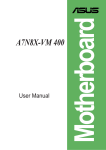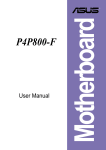Download A7V600-F FRONT.P65
Transcript
User Guide Motherboard A7V600-F/ Maxdata E1490 Checklist First Edition November 2003 Copyright © 2003 ASUSTeK COMPUTER INC. All Rights Reserved. No part of this manual, including the products and software described in it, may be reproduced, transmitted, transcribed, stored in a retrieval system, or translated into any language in any form or by any means, except documentation kept by the purchaser for backup purposes, without the express written permission of ASUSTeK COMPUTER INC. (“ASUS”). Product warranty or service will not be extended if: (1) the product is repaired, modified or altered, unless such repair, modification of alteration is authorized in writing by ASUS; or (2) the serial number of the product is defaced or missing. ASUS PROVIDES THIS MANUAL “AS IS” WITHOUT WARRANTY OF ANY KIND, EITHER EXPRESS OR IMPLIED, INCLUDING BUT NOT LIMITED TO THE IMPLIED WARRANTIES OR CONDITIONS OF MERCHANTABILITY OR FITNESS FOR A PARTICULAR PURPOSE. IN NO EVENT SHALL ASUS, ITS DIRECTORS, OFFICERS, EMPLOYEES OR AGENTS BE LIABLE FOR ANY INDIRECT, SPECIAL, INCIDENTAL, OR CONSEQUENTIAL DAMAGES (INCLUDING DAMAGES FOR LOSS OF PROFITS, LOSS OF BUSINESS, LOSS OF USE OR DATA, INTERRUPTION OF BUSINESS AND THE LIKE), EVEN IF ASUS HAS BEEN ADVISED OF THE POSSIBILITY OF SUCH DAMAGES ARISING FROM ANY DEFECT OR ERROR IN THIS MANUAL OR PRODUCT. SPECIFICATIONS AND INFORMATION CONTAINED IN THIS MANUAL ARE FURNISHED FOR INFORMATIONAL USE ONLY, AND ARE SUBJECT TO CHANGE AT ANY TIME WITHOUT NOTICE, AND SHOULD NOT BE CONSTRUED AS A COMMITMENT BY ASUS. ASUS ASSUMES NO RESPONSIBILITY OR LIABILITY FOR ANY ERRORS OR INACCURACIES THAT MAY APPEAR IN THIS MANUAL, INCLUDING THE PRODUCTS AND SOFTWARE DESCRIBED IN IT. Products and corporate names appearing in this manual may or may not be registered trademarks or copyrights of their respective companies, and are used only for identification or explanation and to the owners’ benefit, without intent to infringe. ii Contents Features Notices ............................................................................................ v Safety information .......................................................................... vi About this guide ............................................................................. vii ASUS contact information .............................................................. ix A7V600-F specifications summary .................................................. x Chapter 1: Product introduction 1.1 1.2 1.3 Welcome! ........................................................................... 1-1 Special features .................................................................. 1-1 1.2.1 Product highlights .................................................. 1-1 1.2.2 Value-added solutions ............................................ 1-3 Motherboard overview ........................................................ 1-4 1.3.1 Major components ................................................. 1-4 1.3.2 Core specifications ................................................ 1-6 Chapter 2: Hardware information 2.1 2.2 2.3 2.4 2.5 2.6 2.7 2.8 Motherboard installation ..................................................... 2-1 2.1.1 Placement direction ............................................... 2-1 2.1.2 Screw holes ........................................................... 2-1 Motherboard layout ............................................................ 2-2 Before you proceed ............................................................ 2-3 Central Processing Unit (CPU) ........................................... 2-4 2.4.1 Overview ................................................................ 2-4 2.4.2 Installing the CPU .................................................. 2-5 System memory ................................................................. 2-6 2.5.1 Overview ................................................................ 2-6 2.5.2 DDR400 Qualified Vendor List ............................... 2-7 2.5.3 Installing a DIMM ................................................... 2-8 2.5.4 Removing a DIMM ................................................. 2-9 Expansion slots ................................................................ 2-10 2.6.1 Installing an expansion card ................................ 2-10 2.6.2 Configuring an expansion card ............................ 2-10 2.6.3 PCI slots .............................................................. 2-12 2.6.4 AGP slot ............................................................... 2-12 2.6.5 CNR slot .............................................................. 2-13 Jumpers ............................................................................ 2-14 Connectors ....................................................................... 2-17 iii Contents Safeguards Chapter 3: Powering up 3.1 3.2 Starting up for the first time ................................................ 3-1 Powering off the computer ................................................. 3-2 Chapter 4: BIOS setup 4.1 4.2 4.3 4.4 4.5 4.6 4.7 iv Managing and updating your BIOS .................................... 4-1 4.1.1 Using ASUS EZ Flash to update the BIOS ............ 4-1 4.1.2 Using AFLASH to update the BIOS ....................... 4-3 BIOS Setup program .......................................................... 4-7 4.2.1 BIOS menu bar ...................................................... 4-8 4.2.2 Legend bar ............................................................. 4-8 Main Menu ........................................................................ 4-10 4.3.1 Primary and Secondary Master/Slave ................. 4-12 4.3.2 Keyboard Features .............................................. 4-16 Advanced Menu ............................................................... 4-17 4.4.1 Chip Configuration ............................................... 4-19 4.4.2 I/O Device Configuration ...................................... 4-22 4.4.3 PCI Configuration ................................................ 4-25 Power Menu ..................................................................... 4-27 4.5.1 Power Up Control ................................................ 4-29 4.5.2 Hardware Monitor ................................................ 4-31 Boot Menu ........................................................................ 4-32 Exit Menu ......................................................................... 4-34 Notices Federal Communications Commission Statement This device complies with FCC Rules Part 15. Operation is subject to the following two conditions: • This device may not cause harmful interference, and • This device must accept any interference received including interference that may cause undesired operation. This equipment has been tested and found to comply with the limits for a Class B digital device, pursuant to Part 15 of the FCC Rules. These limits are designed to provide reasonable protection against harmful interference in a residential installation. This equipment generates, uses and can radiate radio frequency energy and, if not installed and used in accordance with manufacturer’s instructions, may cause harmful interference to radio communications. However, there is no guarantee that interference will not occur in a particular installation. If this equipment does cause harmful interference to radio or television reception, which can be determined by turning the equipment off and on, the user is encouraged to try to correct the interference by one or more of the following measures: • Reorient or relocate the receiving antenna. • Increase the separation between the equipment and receiver. • Connect the equipment to an outlet on a circuit different from that to which the receiver is connected. • Consult the dealer or an experienced radio/TV technician for help. The use of shielded cables for connection of the monitor to the graphics card is required to assure compliance with FCC regulations. Changes or modifications to this unit not expressly approved by the party responsible for compliance could void the user’s authority to operate this equipment. Canadian Department of Communications Statement This digital apparatus does not exceed the Class B limits for radio noise emissions from digital apparatus set out in the Radio Interference Regulations of the Canadian Department of Communications. This class B digital apparatus complies with Canadian ICES-003. v Safety information Electrical safety • To prevent electrical shock hazard, disconnect the power cable from the electrical outlet before relocating the system. • When adding or removing devices to or from the system, ensure that the power cables for the devices are unplugged before the signal cables are connected. If possible, disconnect all power cables from the existing system before you add a device. • Before connecting or removing signal cables from the motherboard, ensure that all power cables are unplugged. • Seek professional assistance before using an adpater or extension cord. These devices could interrupt the grounding circuit. • Make sure that your power supply is set to the correct voltage in your area. If you are not sure about the voltage of the electrical outlet you are using, contact your local power company. • If the power supply is broken, do not try to fix it by yourself. Contact a qualified service technician or your retailer. Operation safety • Before installing the motherboard and adding devices on it, carefully read all the manuals that came with the package. • Before using the product, make sure all cables are correctly connected and the power cables are not damaged. If you detect any damage, contact your dealer immediately. • To avoid short circuits, keep paper clips, screws, and staples away from connectors, slots, sockets and circuitry. • Avoid dust, humidity, and temperature extremes. Do not place the product in any area where it may become wet. • Place the product on a stable surface. • If you encounter technical problems with the product, contact a qualified service technician or your retailer. vi About this guide This user guide contains the information you need when installing the ASUS A7V600-F motherboard. How this guide is organized This manual contains the following parts: • Chapter 1: Product introduction This chapter describes the features of the A7V600-F motherboard. It includes brief descriptions of the special attributes of the motherboard and the new technology it supports. • Chapter 2: Hardware information This chapter lists the hardware setup procedures that you have to perform when installing system components. It includes description of the switches, jumpers, and connectors on the motherboard. • Chapter 3: Powering up This chapter describes the power up sequence and gives information on the BIOS beep codes. • Chapter 4: BIOS setup This chapter tells how to change system settings through the BIOS Setup menus. Detailed descriptions of the BIOS parameters are also provided. vii Conventions used in this guide To make sure that you perform certain tasks properly, take note of the following symbols used throughout this manual. DANGER/WARNING: Information to prevent injury to yourself when trying to complete a task. CAUTION: Information to prevent damage to the components when trying to complete a task. IMPORTANT: Information that you MUST follow to complete a task. NOTE: Tips and additional information to aid in completing a task. Where to find more information Refer to the following sources for additional information and for product and software updates. 1. ASUS Websites The ASUS websites worldwide provide updated information on ASUS hardware and software products. The ASUS websites are listed in the ASUS Contact Information on page ix. 2. Optional Documentation Your product package may include optional documentation, such as warranty flyers, that may have been added by your dealer. These documents are not part of the standard package. viii ASUS contact information ASUSTeK COMPUTER INC. (Asia-Pacific) Address Telephone Web site 150 Li-Te Road, Peitou, Taipei, Taiwan 112 +886-2-2894-3447 www.asus.com.tw Technical Support Telephone(MB/Component) (Notebook) (Server/PC) (Networking) Support fax +886-2-2890-7121 (English) +886-2-2890-7122 (English) +886-2-2890-7123 (English) +886-2-2890-7902 (English) +886-2-2890-7698 ASUS COMPUTER INTERNATIONAL (America) Address Fax E-mail Web site 44370 Nobel Drive, Fremont, CA 94538, USA +1-510-608-4555 [email protected] usa.asus.com Technical Support Telephone (General) (Notebook) Support fax Support e-mail +1-502-995-0883 +1-510-739-3777 +1-502-933-8713 [email protected] ASUS COMPUTER GmbH (Germany and Austria) Address Telephone Fax Online contact Harkort Str. 25, D-40880 Ratingen, Germany +49-2102-95990 +49-2102-959911 www.asuscom.de/sales Technical Support Telephone Fax Online support Web site +49-2102-95990 +49-2102-959911 www.asuscom.de/support www.asuscom.de/news ASUS COMPUTER (Middle East and North Africa) Address Telephone Fax Web site P.O. Box 64133, Dubai, U.A.E. +9714-283-1774 +9714-283-1775 www.ASUSarabia.com ix A7V600-F specifications summary CPU Socket A for AMD Athlon XP/Athlon with Thoroughbred/ Barton Core support Chipset Northbridge: VIA KT600 Southbridge: VIA VT8237 Front Side Bus (FSB) 400/333/266 Mhz Memory 3 x 184-pin DDR DIMM Sockets support a maximum of 3GB unbuffered non-ECC PC2700/2100 DDR SDRAM memory. (Note: PC3200 maximum to 2 DIMMs only.) Visit the ASUS website for the latest qualified DDR400 module list Expansion slots 1 x AGP 8X 5 x PCI 1 x ASUS proprietary CNR connector Storage 2 x UltraATA133/100/66/33 2 x Serial ATA connectors Audio Realtek ALC655 6-channel CODEC S/PDIF out interface LAN Realtek® 8201BL LAN PHY Special Features ASUS MyLogo ASUS EZ Flash Power Loss Restart ASUS C.O.P. (CPU Overheating Protection) ASUS Instant Music Lite Back Panel I/O 1 x Parallel 1 x Serial 1 x PS/2 Keyboard 1 x PS/2 Mouse 1 x Audio I/O 4 x USB 2.0 1 x RJ-45 Port 1 x S/PDIF out port 1 x 1394 port Internal I/O Connectors CPU/power/chassis fan connectors 2 x Serial ATA connectors 20 pin ATX power connector COM2 connector CD/AUX audio connectors Front panel audio connector 2 x USB 2.0 connector supports additional 4 USB 2.0 ports (continued on the next page) x A7V600-F specifications summary BIOS features 2Mb Flash ROM, ASUS Jumperfree, Award BIOS, TCAV, PnP, DMI2.0, WfM2.0, SM BIOS2.3, ASUS EZ Flash, ASUS MyLogo Industry standard PCI 2.2, USB 2.0 Manageability WfM 2.0. DMI 2.0, WOR, WOL, LDCM Form Factor ATX form factor: 12 in x 9.6 in (30.5 cm x 24.5 cm) Support CD contents Device drivers ASUS PC Probe Trend Micro™ PC-cillin 2002 anti-virus software (OEM version) ASUS LiveUpdate Utility * Specifications are subject to change without notice. xi xii Chapter 1 This chapter describes the features of the ASUS A7V600-F motherboard. It includes brief explanations of the special attributes of the motherboard and the new technology it supports. Product introduction Chapter summary 1.1 Welcome! ........................................................ 1-1 1.2 Special features ............................................. 1-1 1.3 Motherboard overview ................................... 1-4 ASUS A7V600-F motherboard 1.1 Welcome! Thank you for buying the ASUS® A7V600-F motherboard! The ASUS A7V600-F motherboard is loaded with the most advanced technologies to deliver the maximum performance for socket A processors. Based on the advanced VIA KT600 chipset with FSB 400 and DDR 400 support, the ASUS A7V600-F also features Serial ATA support, AGP 8X, USB 2.0 as well as 6-channel audio, 10/100 LAN PHY and S/PDIF interfaces. Trademark ASUS features such as ASUS C.O.P., ASUS Instant Music Lite and more are included to ensure the best user experience and value in a motherboard. Before you start installing the motherboard, and hardware devices on it, check the items in your package with the list below. 1.2 Special features 1.2.1 Product highlights 400 FSB K7 Platform The motherboard is loaded with the most advanced technologies to deliver the maximum performance for socket A processors. Based on the advanced VIA KT600 chipset with FSB 400 and DDR 400 support, the ASUS A7V600-F features AGP8X, USB 2.0 as well as a 6-channel audio CODEC. Unique ASUS features such as ASUS C.O.P., ASUS MyLogo and more are included to ensure the best user experience and value in a motherboard. 400MHz FSB Athlon XP CPU support AMD’s Athlon XP 3200+ and all follow-up CPUs now support 400MHz Front Side Bus (FSB) for increased office productivity and enhanced digital media experience. Serial ATA technology The motherboard supports the new Serial ATA technology through the SATA interfaces. The SATA specification allows for thinner, more flexible cables with lower pin count, reduced voltage requirement, and up to 150MB/s data transfer rate. ASUS A7V600-F motherboard user guide 1-1 DDR400 (PC3200) support DDR400 (PC3200), the latest and fastest DDR memory standard, supports bandwidth up to 3.2 GB/s to provide enhanced system performance. (Note: PC3200 maximum to 2 DIMMs only. Visit the ASUS website for the latest qualified DDR400 module list.) AGP 8X support AGP 8X (AGP 3.0) is the next generation VGA interface specification that enables enhanced graphics performance with high bandwidth speeds up 8 x USB 2.0 ports support USB 2.0 is the latest connectivity standard for next generation components and peripherals. USB 2.0 delivers fast transfer speeds up to 40 times faster at 480 MB/s, for easy connectivity and ultra-fast data transfers. The higher bandwidth of USB 2.0 allows connection of devices such as high resolution video conferencing cameras, next generation scanners, printers, and fast storage units. USB 2.0 is backward compatible with USB 1.1. Digital audio support The motherboard provides convenient connectivity to external home theater audio systems via an S/PDIF out interface in the rear panel and an onboard S/PDIF In connector. Experience 5.1-channel surround sound and enhanced 3D audio while playing your favorite DVDs or games. C.O.P. (CPU Overheating Protection) With AMD® Athlon XP™ installed, the motherboard offers automatic CPU Overheating Protection to prolong the life of the entire system. If the CPU temperature exceeds the set criteria, the PC shuts down automatically. ASUS MyLogo™ This new feature present in the A7V600-F motherboard allows you to personalize and add style to your system with customizable boot logos. ASUS EZ Flash BIOS With the ASUS EZ Flash, you can easily update the system BIOS even before loading the operating system. No need to use a DOS-based utility or boot from a floppy disk. 1-2 Chapter 1: Product introduction 1.2.2 Value-added solutions Temperature, fan, and voltage monitoring The CPU temperature is monitored by the ASUS ASIC to prevent overheating and damage. The system fan rotations per minute (RPM) is monitored for timely failure detection. The system voltage levels are monitored to ensure stable supply of current for critical components. ASUS update This utility allows you to update the motherboard BIOS through a userfriendly interface. Connect to the Internet then to the ASUS FTP site nearest you to obtain the latest BIOS version for your motherboard. ASUS A7V600-F motherboard user guide 1-3 1.3 Motherboard overview Before you install the A7V600-F motherboard, familiarize yourself with its physical configuration and available features to facilitate the motherboard installation and future upgrades. A sufficient knowledge of the motherboard specifications will also help you avoid mistakes that may damage the board and its components. 1.3.1 Major components The following are the major components of the A7V600-F motherboard as pointed out in the picture on page 1-5. 1. 4-pin ATX power connector 17. PCI slots 2. CPU socket 18. Audio CODEC 3. North Bridge controller 19. LAN PHY 4. DDR DIMM sockets 20. Mouse port 5. IDE connectors 21. IEEE 1394 port 6. ATX power connector 22. Parallel port 7. Floppy disk connector 23. RJ-45 port 8. AGP slot 24. Line In jack 9. Serial ATA connectors 25. Line Out jack 10. South Bridge controller 26. Microphone jack 11. 27. USB 2.0 ports 1 and 2 Flash ROM 12. Stand-by LED 28. Serial port (COM1) 13. Super I/O controller 29. S/PDIF out port 14. Serial connector 30. USB 2.0 ports 3 and 4 15. CNR slot 31. Keyboard port 16. IEEE1394 controller See page 1-7 for the specifications of each major component. Refer to Chapter 2 for detailed information on the components. 1-4 Chapter 1: Product introduction 1 2 3 4 5 6 7 8 19 9 10 18 17 11 16 20 15 14 13 12 22 21 23 24 25 26 31 30 29 28 ASUS A7V600-F motherboard user guide 27 1-5 1.3.2 Core specifications 1 ATX 12V connector. This power connector connects the 4-pin 12V plug from the ATX 12V power supply. 2 CPU socket. Socket 462 (Socket A) surface mount, Zero Insertion Force (ZIF) socket for the AMD Athlon XP/Athlon Processors. 3 North bridge controller. The VIA® KT600 supports AGP 8X mode, 400/333/266MHz Front Side Bus, and the latest 400/333/266MHz 64-bit memory bus. 4 DDR DIMM sockets. These three 184-pin DIMM sockets support up to 3GB system memory using unbuffered non-ECC PC2700/ 2100 DDR DIMMs. (Note: PC3200 maximum to 2 DIMMs support only. Visit the ASUS website (www.asus.com) for the latest qualified DDR400 module list.) 1-6 5 IDE connectors. These dual-channel bus master IDE connectors support up to four Ultra DMA133/100/66, PIO Modes 3 & 4 IDE devices. Both the primary (blue) and secondary (black) connectors are slotted to prevent incorrect insertion of the IDE ribbon cable. 6 ATX power connector. This 20-pin connector connects to an ATX +12V power supply. The power supply must have at least 1A on the +5V standby lead (+5VSB). 7 Floppy disk connector. This connector accommodates the provided ribbon cable for the floppy disk drive. One side of the connector is slotted to prevent incorrect insertion of the floppy disk cable. 8 AGP slot. This Accelerated Graphics Port (AGP) slot supports 1.5V AGP8X mode graphics cards for 3D graphical applications. 9 SATA connectors. These connectors support Serial ATA HDDs and allows up to 150MB/s data transfer rate, faster than the standard Parallel ATA with 133MB/s. 10 South bridge controller. The VIA® VT8237 integrated peripheral controller supports various I/O functions including 2-channel ATA/ 133 bus master IDE controller, up to eight USB 2.0 ports, LPC Super I/O interface, AC’97 interface and PCI 2.2 interface. 11 Flash ROM. This 2Mb firmware contains the programmable BIOS program. Chapter 1: Product introduction 12 Standby power LED. This LED lights up if there is a standby power on the motherboard. This LED acts as a reminder to turn off the system power before plugging or unplugging devices. 13 Super I/O controller. This Low Pin Count (LPC) interface provides the commonly used Super I/O functionality. The chipset supports a high-performance floppy disk controller for a 360K/720K/1.44M/ 2.88M floppy disk drive, a multi-mode parallel port, two standard compatible UARTs, and a Flash ROM interface. 14 Serial (COM2) connector. This 9-pin connector is for a COM2 cable for an additional serial port. 15 CNR slot. This slot is specifically designed for the Communications and Networking Riser (CNR) card. The CNR supports V.90 analog modem. 16 IEEE 1394 controller. The VIA® VT6307 controller chipset supports two low power IEEE 1394 connectors to allow 100Mbps, 200Mbps, and 400Mbps data transfers between the 1394 devices. 17 PCI slots. These five 32-bit PCI 2.2 expansion slots support bus master PCI cards like SCSI or LAN cards with 133MB/s maximum throughput. 18 Audio CODEC . The ALC 655 is an AC’97 compliant audio CODEC for PC multimedia systems. 19 LAN PHY. The Realtek® 8201BL LAN PHY with the 10/100 MAC built in the VT8237 chipset provides your local area networking needs. Ideal for handling large amounts of data such as video, audio and voice. 20 PS/2 mouse port. This green 6-pin connector is for a PS/2 mouse. 21 IEEE 1394 port. This port connects IEEE 1394-compliant devices like camcorders, VCRs, printers, or digital cameras. 22 Parallel port. This 25-pin port connects a parallel printer, a scanner, or other devices. 23 RJ-45 port. This port allows connection to a Local Area Network (LAN) through a network hub. 24 Line In jack. This Line In (light blue) jack connects a tape player or other audio sources. In 6-channel mode, the function of this jack becomes Rear Speaker Out. ASUS A7V600-F motherboard user guide 1-7 25 Line Out jack. This Line Out (lime) jack connects a headphone or a speaker. In 6-channel mode, the function of this jack becomes Front Speaker Out. 26 Microphone jack. This Mic (pink) jack connects a microphone. In 6-channel mode, the function of this jack becomes Center Speaker/ Subwoofer. Connector 1-8 Headphone/ 2-Speaker 4-Speaker 6-Speaker Light Blue Line In Rear Speaker Out Rear Speaker Out Lime Line Out Front Speaker Out Front Speaker Out Pink Mic In Mic In Center Spkr/Subwoofer 27 USB 2.0 ports 3 and 4. These two 4-pin Universal Serial Bus (USB) ports are available for connecting USB 2.0 devices. 28 Serial port (COM1). This 9-pin serial port is for an additional serial device. 29 S/PDIF out jack. This jack connects to external audio output devices. 30 USB 2.0 ports 1 and 2. These two 4-pin Universal Serial Bus (USB) ports are available for connecting USB 2.0 devices. 31 PS/2 keyboard port. This purple 6-pin connector is for a PS/2 keyboard. Chapter 1: Product introduction Chapter 2 This chapter describes the hardware setup procedures that you have to perform when installing system components. It includes details on the switches, jumpers, and connectors on the motherboard. Hardware information Chapter summary 2.1 Motherboard installation ............................... 2-1 2.2 Motherboard layout ....................................... 2-2 2.3 Before you proceed ....................................... 2-3 2.4 Central Processing Unit (CPU) ..................... 2-4 2.5 System memory ............................................. 2-6 2.6 Expansion slots ........................................... 2-10 2.7 Jumpers ........................................................ 2-14 2.8 Connectors ................................................... 2-17 ASUS A7V600-F motherboard 2.1 Motherboard installation Before you install the motherboard, study the configuration of your chassis to ensure that the motherboard fits into it. The A7V600-F uses the ATX form factor that measures 12 inches x 9.6 inches (30.5 x 24.5 cm). Make sure to unplug the power cord before installing or removing the motherboard. Failure to do so may cause you physical injury and damage motherboard components. 2.1.1 Placement direction When installing the motherboard, make sure that you place it into the chassis in the correct orientation. The edge with external ports goes to the rear part of the chassis as indicated in the image below. 2.1.2 Screw holes Place nine (9) screws into the holes indicated by circles to secure the motherboard to the chassis. Do not overtighten the screws! Doing so may damage the motherboard. Place this side towards the rear of the chassis ASUS A7V600-F motherboard user guide 2-1 2.2 Motherboard layout 24.5cm (9.6in) VIA KT600 Chipset Top:Line In Center:Line Out Accelerated Graphics Port (AGP) LAN PHY SEC_IDE PWR_FAN PRI_IDE CD FLOPPY AUX Below:Mic In 30.5cm (12.0in) USB2.0 Top: T: USB4 RJ-45 B: USB3 ATX Power Connector COM1 DDR DIMM3 (64/72 bit,184-pin module) SPDIF_O DDR DIMM2 (64/72 bit,184-pin module) KBPWR USBPW12 USBPW34 PARALLEL PORT Top: USB1 USB2 1394 CPU_FAN Socket 462 Bottom: ATX12V DDR DIMM1 (64/72 bit,184-pin module) PS/2KBMS T: Mouse B: Keyboard PCI1 SATA2 VIA VT8237 South Bridge PCI2 A7V600-F FP_AUDIO SATA1 PCI3 ® CR2032 3V Lithium Cell CMOS Power ALC655 PCI4 CLRTC COM2 PCI5 VIA VT6307 Chipset 1394_SW CNR1 2-2 Super I/O 2Mbit Low Pin Count USBPW78 USBPW56 SB_PWR BUZZ1 F_PANEL IE1394_1 USB56 USB78 CHA_FAN Chapter 2: Hardware information 2.3 Before you proceed Take note of the following precautions before you install motherboard components or change any motherboard settings. 1. Unplug the power cord from the wall socket before touching any component. 2. Use a grounded wrist strap or touch a safely grounded object or to a metal object, such as the power supply case, before handling components to avoid damaging them due to static electricity. 3. Hold components by the edges to avoid touching the ICs on them. 4. Whenever you uninstall any component, place it on a grounded antistatic pad or in the bag that came with the component. 5. Before you install or remove any component, ensure that the ATX power supply is switched off or the power cord is detached from the power supply. Failure to do so may cause severe damage to the motherboard, peripherals, and/or components. When lit, the green LED (SB_PWR) indicates that the system is ON, in sleep mode, or in soft-off mode, a reminder that you should shut down the system before removing or plugging in any motherboard component. SB_PWR A7V600-F ® A7V600-F Onboard LED ON Standby Power ASUS A7V600-F motherboard user guide OFF Powered Off 2-3 2.4 Central Processing Unit (CPU) 2.4.1 Overview The motherboard provides a Socket A (462) for CPU installation. AMD processors offer gigahertz speeds to support all the latest computing platforms and applications. The A7V600-F supports AthlonTM XP and Athlon TM processors with Thoroughbred/Barton core support. CPU NOTCH TO INNER CORNER AMD™ CPU A7V600-F ® A7V600-F Socket A CPU NOTCH LEVER LOCK Each AMD CPU has a “marked” corner. This corner is indicated with a notch, and/or a golden square or triangle. Refer to this indicator while orienting the CPU. See the next section for installation details. A fan and heatsink should be attached to the CPU to prevent overheating. 2-4 Chapter 2: Hardware information 2.4.2 Installing the CPU Follow these steps to install a CPU: 1. Locate the Socket 462 and open it by pulling the lever gently sideways away from the socket. Then lift the lever upwards. The socket lever must be fully opened (90 to 100 degrees). 2. Insert the CPU with the correct orientation. The notched or golden corner of the CPU must be oriented toward the inner corner of the socket base nearest to the lever hinge. The CPU should drop easily into place. Do not force the CPU into the socket to avoid bending the pins. If the CPU does not fit, check its alignment and look for bent pins. 4. Once completely inserted, press the CPU firmly and close the socket lever until it snaps shut. 5. Place the CPU fan and heatsink on the CPU. The heatsink should entirely cover the CPU. Carefully attach the heatsink locking brace to the plastic clips on the socket base. With the added weight of the CPU fan and heatsink locking brace, no extra force is required to keep the CPU in place Take care not to scrape the motherboard surface when mounting a clampstyle processor fan, or else damage may occur. When mounting a heatsink onto your CPU, make sure that exposed CPU capacitors do not touch the heatsink, or damage may occur! Do not neglect to set the correct Bus Frequency and leave the CPU Multiple setting at default to avoid start-up problems. ASUS A7V600-F motherboard user guide 2-5 2.5 System memory 2.5.1 Overview 80 Pins 104 Pins DIMM3 DIMM2 DIMM1 The motherboard comes with three Double Data Rate (DDR) Dual Inline Memory Module (DIMM) sockets. These sockets support up to 3GB system memory using 184-pin unbuffered non-ECC PC2700/2100 DDR DIMMs. (Note: PC3200 maximum to 2 DIMMs support only. Visit the ASUS website (www.asus.com) for the latest qualified DDR400 module list.) A7V600-F ® A7V600-F 184-Pin DDR DIMM Sockets A DDR DIMM is keyed with a notch so that it fits in only one direction. DO NOT force a DIMM into a socket to avoid damaging the DIMM. The DDR SDRAM technology evolved from the mainstream PC66, PC100, PC133 memory known as Single Data Rate (SDR) SDRAM. DDR memory however, has the ability to perform two data operations in one clock cycle, thus providing twice the throughput of SDR memory. For example, a 266MHz DDR DIMM will support a 133MHz memory bus, and a 333MHz DDR DIMM will support a 166MHz memory bus. DDR Data Transfer Rate DDR Base Frequency 400MHz 200MHz 333MHz 166MHz 266MHz 133MHz A DDR DIMM has the same physical dimensions as an SDR DIMM, but it has a 184-pin footprint compared to the 168-pin of the SDR DIMM. Also, a DDR DIMM is single notched while an SDR DIMM is double notched. Therefore, a DDR DIMM is not backward compatible with SDR, and should be installed only in a socket specially designed for DDR DIMMs. 2-6 Chapter 2: Hardware information 2.5.2 DDR400 Qualified Vendor List The following table lists the PC3200-DDR400 memory modules that have been tested and qualified for use with this motherboard. 2.5.2.1 DDR400 One DIMM support only Vendor Size Type P/N Chip Samsung 512MB DS M368L6432ETM-CCC K4H560838E-TCCC KingMax 512MB DS MPXC22D-38KT3R KDL388P4EA-50 Micron 256MB SS MT8VDDT3264AG-40BC4 MT46V32MTG-5BC Micron 512MB DS MT16VDDT6464AG-40BC4 MT46V32M8TG-5BC 2.5.2.2 DDR400 Two DIMM support only Vendor Size Type P/N Chip GEIL 512MB DS MAG16UL3264D1TG5A-KC GL3LC32G88TG-5A Micron 512MB DS MT16VDDT6464AG-40BC4 MT46V32M8TG-5BC Nanya 256MB SS NT256D64S88B1G-5T NT5DS32M8BT-5T Make sure to use only the tested and qualified DDR400 DIMMs listed above. Other DDR DIMMs manufactured by other vendors may not be suitable for this motherboard. Visit the ASUS website (www.asus.com) for the latest qualified vendor DDR400 module list. ASUS A7V600-F motherboard user guide 2-7 2.5.3 Installing a DIMM Make sure to unplug the power supply before adding or removing DIMMs or other system components. Failure to do so may cause severe damage to both the motherboard and the components. Follow these steps to install a DIMM. 1. Unlock a DIMM socket by pressing the retaining clips outward. 2. Align a DIMM on the socket such that the notch on the DIMM matches the break on the socket. Unlocked Retaining Clip 3. Firmly insert the DIMM into the socket until the retaining clips snap back in place and the DIMM is properly seated. Locked Retaining Clip 2-8 Chapter 2: Hardware information 2.5.4 Removing a DIMM Follow these steps to remove a DIMM. 1. Simultaneously press the retaining clips outward to unlock the DIMM. Support the DIMM lightly with your fingers when pressing the retaining clips. The DIMM might get damaged when it flips out with extra force. 2. Remove the DIMM from the socket. ASUS A7V600-F motherboard user guide 2-9 2.6 Expansion slots In the future, you may need to install expansion cards. The motherboard has five PCI slots and one Accelerated Graphics Port (AGP) slot. The following sub-sections describe the slots and the expansion cards that they support. Make sure to unplug the power cord before adding or removing expansion cards. Failure to do so may cause you physical injury and damage motherboard components. 2.6.1 Installing an expansion card Follow these steps to install an expansion card. 1. Before installing the expansion card, read the documentation that came with it and make the necessary hardware settings for the card. 2. Remove the system unit cover (if your motherboard is already installed in a chassis). 3. Remove the bracket opposite the slot that you intend to use. Keep the screw for later use. 4. Align the card connector with the slot and press firmly until the card is completely seated on the slot. 5. Secure the card to the chassis with the screw you removed earlier. 6. Replace the system cover. 2.6.2 Configuring an expansion card After installing the expansion card, configure the it by adjusting the software settings. 1. Turn on the system and change the necessary BIOS settings, if any. See Chapter 4 for information on BIOS setup. 2. Assign an IRQ to the card. Refer to the tables on the next page. 3. Install the software drivers for the expansion card. 2-10 Chapter 2: Hardware information Standard Interrupt Assignments IRQ 0 1 2 3* 4* 5* 6 7* 8 9* 10* 11* 12* 13 14* 15* * Priority 1 2 N/A 11 12 13 14 15 3 4 5 6 7 8 9 10 Standard Function System Timer Keyboard Controller Programmable Interrupt Communications Port (COM2) Communications Port (COM1) Sound Card (sometimes LPT2) Floppy Disk Controller Printer Port (LPT1) System CMOS/Real Time Clock ACPI Mode when used IRQ Holder for PCI Steering IRQ Holder for PCI Steering PS/2 Compatible Mouse Port Numeric Data Processor Primary IDE Channel Secondary IDE Channel These IRQs are usually available for ISA or PCI devices. IRQ assignments for this motherboard PCI slot 1 PCI slot 2 PCI slot 3 PCI slot 4 PCI slot 5 AGP slot USB 1.1 UHCI 1 USB 1.1 UHCI 2 USB 1.1 UHCI 3 USB 1.1 UHCI 4 USB 2.0 EHCI USB Device AC97 Codec Onboard LAN Onboard IDE Onboard 1394 Onboard SATA A B C D E F G H — — — shared — — — — shared — — — — — — — — shared — — — — — — — — shared — — — — — — — — shared — — — — shared — — — — — — — — — — — shared — — — — — — — shared — — — — — — — — shared — — — — — — — shared — — — — — — — — shared — — — — — — — — shared — — — — — — shared — — — shared — — — — — — — — — shared — — — — shared — — — — — — — — — — shared — — — When using PCI cards on shared slots, ensure that the drivers support “Share IRQ” or that the cards do not need IRQ assignments. Otherwise, conflicts will arise between the two PCI groups, making the system unstable and the card inoperable. ASUS A7V600-F motherboard user guide 2-11 2.6.3 PCI slots There are five 32-bit PCI slots in this motherboard. The slots support PCI cards such as a LAN card, SCSI card, USB card, and other cards that comply with PCI specifications. The following figure shows a LAN card installed on a PCI slot. 2.6.4 AGP slot This motherboard has an Accelerated Graphics Port (AGP) slot that supports +1.5V AGP cards. When you buy an AGP card, make sure that you ask for one with +1.5V specification. Note the notches on the card golden fingers to ensure that they fit the AGP slot on your motherboard. Install only 1.5V AGP cards on this motherboard! A7V600-F ® Keyed for 1.5v A7V600-F Accelerated Graphics Port (AGP) 2-12 Chapter 2: Hardware information 2.6.5 CNR slot The Communications and Networking Riser (CNR) slot supports interface cards that integrates audio, modem, and network functionality. The CNR specification supports interfaces including: • Audio Codec ‘97 (AC ’97) - for audio and/or modem functions • System Management Bus (SMB) - for Plug-n-Play functionality • Power - to provide the signals required for power management, and the main power supplies to operate the CNR circuitry The CNR is tagged to replace the current Audio Modem Riser (AMR) slot because of its flexibility and added features. Also, the CNR slot does not take up the motherboard space for one PCI slot because it is a shared slot; rather, it provides you more options. A7V600-F ® A7V600-F Communication & Networking Riser Slot ASUS A7V600-F motherboard user guide 2-13 2.7 Jumpers 1. Keyboard power (3-pin KBPWR) When set to pins 2-3 (+5VSB), you can use the keyboard to wake from Suspend-to-RAM or Suspend-to-Disk modes. Set to pins 1-2(+5V) if you want support for Suspend mode only. This feature requires an ATX power supply that can supply at least 1A on the +5VSB lead, and a corresponding setting in the BIOS.(see section 4.5.1 Power Up Control). KBPWR 1 2 2 3 +5V +5VSB (Default) A7V600-F ® A7V600-F Keyboard Power Setting 2. IEEE 1394 Setting (3-pin 1394_SW) This jumper permits selection of the IEEE 1394 onboard connector for connection of the IEEE 1394 module. The default setting [1-2] enables the onboard IEEE 1394 connector. Disable the connector by changing the jumpers to [2-3]. 1394_SW A7V600-F ® 1 2 A7V600-F 1394 Setting 2-14 2 3 Enable (Default) Disable Chapter 2: Hardware information 3. USB device wake-up (3-pin USBPW12, USBPW34, USBPW56, USBPW78) Set these jumpers to +5V to wake up the computer from S1 sleep mode (CPU stopped, DRAM refreshed, system running in low power mode) using the connected USB devices. Set to +5VSB to wake up from S3 sleep mode (no power to CPU, DRAM in slow refresh, power supply in reduced power mode). All jumpers are set to pins 2-3 (+5VSB) by default. The USBPW12 and USBPW34 jumpers are for the rear USB ports. The USBPW56 and USBPW78 jumpers are for the internal USB header that you can connect to the front USB ports. 1. This feature requires a power supply that can provide at least 2A on the +5VSB lead when these jumpers are set to +5VSB. Otherwise, the system does not power up. 2. The total current consumed must NOT exceed the power supply capability (+5VSB) whether under normal condition or in sleep mode. USBPW12 USBPW34 2 3 1 2 +5V +5VSB (Default) USBPW78 USBPW56 A7V600-F ® 1 2 A7V600-F USB Device Wake Up +5V ASUS A7V600-F motherboard user guide 2 3 +5VSB (Default) 2-15 4. Clear RTC RAM (CLRTC) These jumpers allow you to clear the Real Time Clock (RTC) RAM in CMOS. You can clear the CMOS memory of date, time, and system setup parameters by erasing the CMOS RTC RAM data. The RAM data in CMOS is powered by the onboard button cell battery. To erase the RTC RAM: 1. Turn OFF the computer and unplug the power cord. 2. Remove the battery. 3. Move the jumper cap to pin [1-2] to clear CMOS then replace the jumper cap back to pin [2-3] after 3 seconds. 4. Re-install the battery. 5. Plug the power cord and turn ON the computer. 6. Hold down the <Del> key during the boot process and enter BIOS setup to re-enter data. CLRTC A7V600-F ® 2 1 Clear CMOS 3 2 Normal (Default) A7V600-F Clear RTC RAM 2-16 Chapter 2: Hardware information 2.8 Connectors This section describes and illustrates the internal connectors on the motherboard. Always connect ribbon cables with the red stripe to Pin 1 on the connectors. Pin 1 is usually on the side closest to the power connector on hard drives and CD-ROM drives, but may be on the opposite side on floppy disk drives. 1. Floppy disk drive connector (34-1 pin FLOPPY) This connector supports the provided floppy drive ribbon cable. After connecting one end to the motherboard, connect the other end to the floppy drive. (Pin 5 is removed to prevent incorrect insertion when using ribbon cables with pin 5 plug). FLOPPY NOTE: Orient the red markings on the floppy ribbon cable to PIN 1. A7V600-F ® PIN 1 A7V600-F Floppy Disk Drive Connector ASUS A7V600-F motherboard user guide 2-17 2. IDE connectors (40-1 pin PRI_IDE, SEC_IDE) This connector supports the provided UltraDMA133/100/66 IDE hard disk ribbon cable. Connect the cable’s blue connector to the primary (recommended) or secondary IDE connector, then connect the gray connector to the UltraDMA133/100/66 slave device (hard disk drive) and the black connector to the UltraDMA133/100/66 master device. It is recommended that you connect non-UltraDMA133/100/66 devices to the secondary IDE connector. If you install two hard disks, you must configure the second drive as a slave device by setting its jumper accordingly. Refer to the hard disk documentation for the jumper settings. BIOS supports specific device bootup. If you have more than two UltraDMA133/100/66 devices, purchase another UltraDMA133/ 100/66 cable. You may configure two hard disks to be both master devices with two ribbon cables – one for the primary IDE connector and another for the secondary IDE connector. 1. Pin 20 on each IDE connector is removed to match the covered hole on the UltraDMA cable connector. This prevents incorrect orientation when you connect the cables. ® PIN 1 SEC_IDE A7V600-F PRI_IDE 2. The hole near the blue connector on the UltraDMA133/100/66 cable is intentional. NOTE: Orient the red markings (usually zigzag) on the IDE ribbon cable to PIN 1. PIN 1 A7V600-F IDE Connectors For UltraDMA133/100/66 IDE devices, use an 80-conductor IDE cable. The UltraDMA/66 cable included in the motherboard package also supports UltraDMA133/100. 2-18 Chapter 2: Hardware information 3. Front panel audio connector (10-1 pin FP_AUDIO) This is an interface for the Intel front panel audio cable that allow convenient connection and control of audio devices. BLINE_OUT_L AGND +5VA BLINE_OUT_R Make sure to remove the caps from the Line out_R, BLINE_OUT_R, Line out_L and BLINE_OUT_L jumpers if you installed the Intel front panel audio cable. FP_AUDIO A7V600-F MIC2 MICPWR Line out_R NC Line out_L ® A7V600-F Front Panel Audio Connector 4. CPU, Chassis, and Power Fan Connectors (3-pin CPU_FAN, PWR_FAN, CHA_FAN) The fan connectors support cooling fans of 350mA~740mA (8.88W max.) or a total of 1A~2.22A (26.64W max.) at +12V. Connect the fan cables to the fan connectors on the motherboard, making sure that the black wire of each cable matches the ground pin of the connector. GND +12V Rotation Do not forget to connect the fan cables to the fan connectors. Lack of sufficient air flow within the system may damage the motherboard components. These are not jumpers! DO NOT place jumper caps on the fan connectors! CPU_FAN PWR_FAN Rotation +12V GND A7V600-F ® A7V600-F 12-Volt Fan Connectors ASUS A7V600-F motherboard user guide Rotation +12V GND CHA_FAN 2-19 5. ATX power connectors (20-pin ATXPWR1) These connectors connect to an ATX 12V power supply. The plugs from the power supply are designed to fit these connectors in only one orientation. Find the proper orientation and push down firmly until the connectors completely fit. In addition to the 20-pin ATXPWR connector, this motherboard requires that you connect the 4-pin ATX +12V power plug to provide sufficient power to the CPU. 1. Do not forget to connect the 4-pin ATX +12V power plug. Otherwise, the system does not boot up. 2. Make sure that your ATX 12V power supply can provide 8A on the +12V lead and at least 1A on the +5-volt standby lead (+5VSB). The minimum recommended wattage is 230W, or 300W for a fully configured system. The system may become unstable and may experience difficulty powering up if the power supply is inadequate. ATX12V ATXPWR A7V600-F ® +3.3VDC -12.0VDC GND PS_ON# GND GND GND -5.0VDC +5.0VDC +5.0VDC +3.3VDC +12V DC +3.3VDC GND GND +5.0VDC GND +5.0VDC GND PWR_OK +5VSB +12.0VDC +12V DC GND A7V600-F ATX Power Connectors TPA0GND TPB0+12V GND 6. IEEE 1394 connector (10-1 pin IE1394_1) This connector is for an optional 1394 module. Attach the 10-1 pin 394 cable plug from the module to this connector. You may also connect a 1394-compliant internal hard disk to this connector. A7V600-F ® 1 A7V600-F IEEE-1394 Connector 2-20 TPA0+ GND TPB0+ +12V IE1394_1 Chapter 2: Hardware information A7V600-F USB+5V USB_P8USB_P8+ GND NC USB+5V USB_P6USB_P6+ GND NC 7. USB header (4-1 pin USB56, USB78) If the USB ports on the rear panel are inadequate, a USB header is available for additional USB ports. The USB header complies with USB 2.0 specification that supports up to 480 Mbps connection speed. This speed advantage over the conventional 12 Mbps on USB 1.1. If your package came with a USB 2.0/GAME module, connect the USB cable to this header. The module has two USB 2.0 ports that support the next generation USB peripherals such as high resolution cameras, scanners, and printers. ® A7V600-F USB 2.0 Headers USB78 1 USB+5V USB_P7USB_P7+ GND 1 USB+5V USB_P5USB_P5+ GND USB56 Right Audio Channel Ground Ground Left Audio Channel 8. Internal audio connectors (4-pin CD, AUX) These connectors allow you to receive stereo audio input from sound sources such as a CD-ROM, TV tuner, or MPEG card. AUX(White) A7V600-F ® CD(Black) A7V600-F Internal Audio Connectors ASUS A7V600-F motherboard user guide 2-21 SATA2 SATA1 GND RSATA_TXP1 RSATA_TXN1 GND RSATA_RXP1 RSATA_RXN1 GND A7V600-F GND RSATA_TXP2 RSATA_TXN2 GND RSATA_RXP2 RSATA_RXN2 GND 9. Serial ATA connectors (7 pin SATA1, SATA2) These next generation connectors support the thin Serial ATA cables for Serial ATA hard disks. The current Serial ATA interface allows up to 150MB/s data transfer rate, faster than the standard parallel ATA with 133MB/s (UltraATA133). ® A7V600-F SATA Connectors 10. Serial Port 2 connector (10-1 pin COM2) This connector accomodates a second serial port using a serial port bracket. Connect the bracket cable to this connector then install the bracket into a slot opening at the back of the system chassis. COM2 PIN 1 A7V600-F ® A7V600-F Serial COM2 Bracket 2-22 Chapter 2: Hardware information 11. System panel connector (20-pin PANEL1) This connector accommodates several system front panel functions. ATX Power Switch* PLED+ PLEDPWR GND Power LED HDLED+ HDLEDGround Reset F_PANEL A7V600-F ® HDLED Reset SW A7V600-F Front Panel Audio Connector • System Power LED Lead (2-pin PLED) This 2-pin connector connects to the system power LED. The LED lights up when you turn on the system power, and blinks when the system is in sleep mode. • ATX Power Switch/Soft-off Switch Lead (2-pin PWR) This connector connects a switch that controls the system power. Pressing the power switch turns the system between ON and SLEEP, or ON and SOFT OFF, depending on the BIOS or OS settings. Pressing the power switch while in the ON mode for more than 4 seconds turns the system OFF. • Reset Switch Lead (2- pin RESET) This 2-pin connector connects to the case-mounted reset switch for rebooting the system without turning-off the system power. • Hard Disk Activity Lead (2-pin IDE_LED) This connector supplies power to the hard disk activity LED. The read or write activities of any device connected to the primary or secondary IDE connector cause this LED to light up. ASUS A7V600-F motherboard user guide 2-23 2-24 Chapter 2: Hardware information Chapter 3 This chapter describes the power up sequence and gives information on the BIOS beep codes. Powering up Chapter summary 3.1 Starting up for the first time .......................... 3-1 3.2 Powering off the computer ........................... 3-2 ASUS A7V600-F motherboard 3.1 Starting up for the first time 1. After making all the connections, replace the system case cover. 2. Be sure that all switches are off. 3. Connect the power cord to the power connector at the back of the system chassis. 4. Connect the power cord to a power outlet that is equipped with a surge protector. 5. Turn on the devices in the following order: a. Monitor b. External SCSI devices (starting with the last device on the chain) c. System power 6. After applying power, the power LED on the system front panel case lights up. For ATX power supplies, the system LED lights up when you press the ATX power switch. If your monitor complies with “green” standards or if it has a “power standby” feature, the monitor LED may light up or switch between orange and green after the system LED turns on. The system then runs the power-on tests. While the tests are running, the BIOS beeps or additional messages appear on the screen. If you do not see anything within 30 seconds from the time you turned on the power, the system may have failed a power-on test. Check the jumper settings and connections or call your retailer for assistance. 7. At power on, hold down <Delete> to enter BIOS Setup. Follow the instructions in Chapter 4. ASUS A7V600-F motherboard user guide 3-1 3.2 Powering off the computer Using the OS shut down function If you use Windows 98SE/ME/2000/XP, click the Start button, click Shut Down, then the OK button to shut down the computer. The power supply should turn off after Windows shuts down. Using the dual function power switch While the system is ON, pressing the power switch for less than 4 seconds puts the system to sleep mode or to soft-off mode, depending on the BIOS setting. Pressing the power switch for more than 4 seconds lets the system enter the soft-off mode regardless of the BIOS setting. See section “4.5 Power Menu” in Chapter 4. 3-2 Chapter 3: Powering up Chapter 4 This chapter tells how to change system settings through the BIOS Setup menus. Detailed descriptions of the BIOS parameters are also provided. BIOS setup Chapter summary 4.1 Managing and updating your BIOS .............. 4-1 4.2 BIOS Setup program ...................................... 4-7 4.3 Main Menu .................................................... 4-10 4.4 Advanced Menu ........................................... 4-17 4.5 Power Menu .................................................. 4-27 4.6 Boot Menu .................................................... 4-32 4.7 Exit Menu ...................................................... 4-34 ASUS A7V600-F motherboard 4.1 Managing and updating your BIOS It is recommended that you save a copy of the motherboard’s original BIOS to a bootable floppy disk in case you need to reinstall the original BIOS later. 4.1.1 Using ASUS EZ Flash to update the BIOS The ASUS EZ Flash feature allows you to easily update the BIOS without having to go through the long process of booting from a diskette and using a DOS-based utility. The EZ Flash is built-in the BIOS firmware so it is accessible by simply pressing <Alt> + <F2> during the Power-On Self Tests (POST). Follow these steps to update the BIOS using ASUS EZ Flash. 1. Download the latest BIOS file from the ASUS website (see ASUS contact information on page x). Save the file to a floppy disk. Write down the BIOS file name on a piece of paper. You need to type the exact BIOS file name at the EZ Flash screen. 2. Reboot the computer. 3. To use EZ Flash, press <Alt> + <F2> during POST to display the following screen. ASUS EZ Flash V1.00 Copyright (C) 2002, ASUSTeK COMPUTER INC. [Onboard BIOS Information] BIOS Version : ASUS A7V-MAX ACPI BIOS Revision 1001 Beta BIOS Model : A7V-MAX BIOS Built Date : 06/03/03 Please Enter File Name for NEW BIOS: _ *Note: EZ Flash will copy file from A:\, Press [ESC] to reboot The BIOS information in the above screen is for reference only. What you see on your screen may not be exactly the same as shown. 4. Insert the disk that contains the new BIOS file into the floppy drive. You will receive the error message, “WARNING! Device not ready.” if you proceed to step 5 without the disk in the drive. ASUS A7V600-F motherboard user guide 4-1 5. At the prompt, “Please Enter File Name for NEW BIOS: _”, type in the BIOS file name that you downloaded from the ASUS website, then press <Enter>. EZ Flash will automatically access drive A to look for the file name that you typed. When found, the following message appears on screen. [BIOS Information in File] BIOS Version: A7V-MAX Boot Block WARNING! Continue to update the BIOS (Y/N)? _ If you accidentally typed in a wrong BIOS file name, the error message, “WARNING! File not found.” appears. Press <Enter> to remove the message, then type in the correct file name. Press <Enter>. 6. At the above prompt, type Y to continue with the update process. Pressing N exits the EZ Flash screen and reboots the system without updating the BIOS. The following prompts appear if you typed Y. Flash Memory: PMC PM49FL002 1. Update Main BIOS area (Y/N)? _ 7. Press Y to completely update the main BIOS area. DO NOT shutdown or reset the system while updating the BIOS boot block area! Doing so may cause system boot failure. 8. When the update process is done, the message, “Press a key to reboot” appears. Press any key to reboot the system with the new BIOS. 4-2 Chapter 4: BIOS Setup 4.1.2 Using AFLASH to update the BIOS Creating a bootable disk AFLASH.EXE is a Flash Memory Writer utility that updates the BIOS by uploading a new BIOS file to the programmable flash ROM on the motherboard. This file works only in DOS mode. To determine the BIOS version of your motherboard, check the last four numbers of the code displayed on the upper left-hand corner of your screen during bootup. Larger numbers represent a newer BIOS file. 1. Type FORMAT A:/S at the DOS prompt to create a bootable system disk. DO NOT copy AUTOEXEC.BAT and CONFIG.SYS to the disk. 2. Type COPY D:\AFLASH\AFLASH.EXE A:\ (assuming D is your CD-ROM drive) to copy AFLASH.EXE to the boot disk you created. AFLASH works only in DOS mode. It does not work in the DOS prompt within Windows, and does not work with certain memory drivers that may be loaded when you boot from the hard drive. It is recommended that you reboot using a floppy disk. 3. Reboot the computer from the floppy disk. BIOS setup must specify “Floppy” as the first item in the boot sequence. 4. In DOS mode, type A:\AFLASH <Enter> to run AFLASH. If the word “unknown” appears after Flash Memory:, the memory chip is either not programmable or is not supported by the ACPI BIOS and therefore, cannot be programmed by the Flash Memory Writer utility. ASUS A7V600-F motherboard user guide 4-3 5. Select 1. Save Current BIOS to File from the Main menu and press <Enter>. The Save Current BIOS To File screen appears. 6. Type a filename and the path, for example, A:\XXX-XX.XXX, then press <Enter>. 4-4 Chapter 4: BIOS Setup Updating the BIOS Update the BIOS only if you have problems with the motherboard and you are sure that the new BIOS revision will solve your problems. Careless updating may result to more problems with the motherboard! 1. Download an updated ASUS BIOS file from the Internet (WWW or FTP) (see ASUS CONTACT INFORMATION on page x for details) and save to the boot floppy disk you created earlier. 2. Boot from the floppy disk. 3. At the “A:\” prompt, type AFLASH and then press <Enter>. 4. At the Main Menu, type 2 then press <Enter>. The Update BIOS Including Boot Block and ESCD screen appears. 5. Type the filename of your new BIOS and the path, for example, A:\XXX-XX.XXX, then press <Enter>. To cancel this operation, press <Enter>. 6. When prompted to confirm the BIOS update, press Y to start the update. ASUS A7V600-F motherboard user guide 4-5 7. The utility starts to program the new BIOS information into the Flash ROM. The boot block is updated automatically only when necessary. This minimizes the possibility of boot problems in case of update failures. When the programming is done, the message “Flashed Successfully” appears. 8. Follow the onscreen instructions to continue. If you encounter problems while updating the new BIOS, DO NOT turn off the system because this may cause boot problems. Just repeat the process, and if the problem persists, load the original BIOS file you saved to the boot disk. If the Flash Memory Writer utility is not able to successfully update a complete BIOS file, the system may not boot. If this happens, call the ASUS service center for support. 4-6 Chapter 4: BIOS Setup 4.2 BIOS Setup program This motherboard supports a programmable Flash ROM that you can update using the provided utility described in section “4.1 Managing and updating your BIOS.” Use the BIOS Setup program when you are installing a motherboard, reconfiguring your system, or prompted to “Run Setup”. This section explains how to configure your system using this utility. Even if you are not prompted to use the Setup program, you may want to change the configuration of your computer in the future. For example, you may want to enable the security password feature or make changes to the power management settings. This requires you to reconfigure your system using the BIOS Setup program so that the computer can recognize these changes and record them in the CMOS RAM of the Flash ROM. The Flash ROM on the motherboard stores the Setup utility. When you start up the computer, the system provides you with the opportunity to run this program. Press <Delete> during the Power-On Self Test (POST) to enter the Setup utility, otherwise, POST continues with its test routines. If you wish to enter Setup after POST, restart the system by pressing <Ctrl> + <Alt> + <Delete>, or by pressing the reset button on the system chassis. You can also restart by turning the system off and then back on. Do this last option only if the first two failed. The Setup program is designed to make it as easy to use as possible. It is a menu-driven program, which means you can scroll through the various sub-menus and make your selections among the predetermined choices. Because the BIOS software is constantly being updated, the following BIOS setup screens and descriptions are for reference purposes only, and may not exactly match what you see on your screen. ASUS A7V600-F motherboard user guide 4-7 4.2.1 BIOS menu bar The top of the screen has a menu bar with the following selections: MAIN Use this menu to make changes to the basic system configuration. ADVANCED Use this menu to enable and make changes to the advanced features. POWER Use this menu to configure and enable Power Management features. BOOT Use this menu to configure the default system device used to locate and load the Operating System. EXIT Use this menu to exit the current menu or to exit the Setup program. To access the menu bar items, press the right or left arrow key on the keyboard until the desired item is highlighted. 4.2.2 Legend bar At the bottom of the Setup screen is a legend bar. The keys in the legend bar allow you to navigate through the various setup menus. The following table lists the keys found in the legend bar with their corresponding functions. Navigation Key(s) Function Description <F1> or <Alt + H> Displays the General Help screen from anywhere in the BIOS Setup <Esc> Jumps to the Exit menu or returns to the main menu from a sub-menu Left or Right arrow Selects the menu item to the left or right Up or Down arrow Moves the highlight up or down between fields - (minus key) Scrolls backward through the values for the highlighted field + (plus key) or spacebar Scrolls forward through the values for the highlighted field <Enter> Brings up a selection menu for the highlighted field <F5> Resets the current screen to its Setup Defaults <F10> Saves changes and exits Setup 4-8 Chapter 4: BIOS Setup General help In addition to the Item Specific Help window, the BIOS setup program also provides a General Help screen. You may launch this screen from any menu by simply pressing <F1> or the <Alt> + <H> combination. The General Help screen lists the legend keys and their corresponding functions. Saving changes and exiting the Setup program See “4.7 Exit Menu” for detailed information on saving changes and exiting the setup program. Scroll bar When a scroll bar appears to the right of a help window, it indicates that there is more information to be displayed that will not fit in the window. Use <PgUp> and <PgDn> or the up and down arrow keys to scroll through the entire help document. Press <Home> to display the first page, press <End> to go to the last page. To exit the help window, press <Enter> or <Esc>. Sub-menu Note that a right pointer symbol (as shown on the left) appears to the left of certain fields. This pointer indicates that you can display a sub-menu from this field. A sub-menu contains additional options for a field parameter. To display a sub-menu, move the highlight to the field and press <Enter>. The submenu appears. Use the legend keys to enter values and move from field to field within a sub-menu as you would within a menu. Use the <Esc> key to return to the main menu. Take some time to familiarize yourself with the legend keys and their corresponding functions. Practice navigating through the various menus and sub-menus. If you accidentally make unwanted changes to any of the fields, use the set default hot key <F5> to load the Setup default values. While moving around through the Setup program, note that explanations appear in the Item Specific Help window located to the right of each menu. This window displays the help text for the currently highlighted field. ASUS A7V600-F motherboard user guide 4-9 4.3 Main Menu When you enter the Setup program, the following screen appears. System Time [XX:XX:XX] Sets the system to the time that you specify (usually the current time). The format is hour, minute, second. Valid values for hour, minute and second are Hour: (00 to 23), Minute: (00 to 59), Second: (00 to 59). Use the <Tab> or <Shift> + <Tab> keys to move between the hour, minute, and second fields. System Date [XX/XX/XXXX] Sets the system to the date that you specify (usually the current date). The format is month, day, year. Valid values for month, day, and year are Month: (1 to 12), Day: (1 to 31), Year: (up to 2099). Use the <Tab> or <Shift> + <Tab> keys to move between the month, day, and year fields. Legacy Diskette A, B [1.44M, 3.5 in.] Sets the type of floppy drive installed. Configuration options: [None] [360K, 5.25 in.] [1.2M , 5.25 in.] [720K , 3.5 in.] [1.44M, 3.5 in.] [2.88M, 3.5 in.] 4-10 Chapter 4: BIOS Setup Supervisor Password [Disabled] / User Password [Disabled] These fields allow you to set passwords. To set a password, highlight the appropriate field and press <Enter>. Type in a password then press <Enter>. You can type up to eight alphanumeric characters. Symbols and other characters are ignored. To confirm the password, type the password again and press <Enter>. The password is now set to [Enabled]. This password allows full access to the BIOS Setup menus. To clear the password, highlight this field and press <Enter>. The same dialog box as above appears. Press <Enter>. The password is set to [Disabled]. A note about passwords The BIOS Setup program allows you to specify passwords in the Main menu. The passwords control access to the BIOS during system startup. Passwords are not case sensitive, meaning, passwords typed in either uppercase or lowercase letters are accepted. The BIOS Setup program allows you to specify two different passwords: a Supervisor password and a User password. If you did not set a Supervisor password, anyone can access the BIOS Setup program. If you did, the Supervisor password is required to enter the BIOS Setup program and to gain full access to the configuration fields. Forgot the password? If you forget your password, you can clear it by erasing the CMOS Real Time Clock (RTC) RAM. The RAM data containing the password information is powered by the onboard button cell battery. See section “2.7 Switches and jumpers” for information on how to erase the RTC RAM. Halt On [All Errors] This field specifies the types of errors that will cause the system to halt. Configuration options: [All Errors] [No Error] [All but Keyboard] [All but Disk] [All but Disk/Keyboard] Installed Memory [XXX MB] This field automatically displays the amount of conventional memory detected by the system during the boot process. ASUS A7V600-F motherboard user guide 4-11 4.3.1 Primary and Secondary Master/Slave Type [Auto] Select [Auto] to automatically detect an IDE hard disk drive. If automatic detection is successful, Setup automatically fills in the correct values for the remaining fields on this sub-menu. If automatic detection fails, this may be because the hard disk drive is too old or too new. If the hard disk was already formatted on an older system, Setup may detect incorrect parameters. In these cases, select [User Type HDD] to manually enter the IDE hard disk drive parameters. Refer to the next section for details. Before attempting to configure a hard disk drive, make sure you have the correct configuration information supplied by the drive manufacturer. Incorrect settings may cause the system to fail to recognize the installed hard disk. 4-12 Chapter 4: BIOS Setup [User Type HDD] Manually enter the number of cylinders, heads and sectors per track for the drive. Refer to the drive documentation or on the drive label for this information. After entering the IDE hard disk drive information into BIOS, use a disk utility, such as FDISK, to partition and format new IDE hard disk drives. This is necessary so that you can write or read data from the hard disk. Make sure to set the partition of the Primary IDE hard disk drives to active. If no drive is installed or if you are removing a drive and not replacing it, select [None]. Other options for the Type field are: [CD-ROM] - for IDE CD-ROM drives [LS-120] - for LS-120 compatible floppy disk drives [ZIP] - for ZIP-compatible disk drives [MO] - for IDE magneto optical disk drives [Other ATAPI Device] - for IDE devices not listed here After making your selections on this sub-menu, press the <Esc> key to return to the Main menu. When the Main menu appears, the hard disk drive field displays the size for the hard disk drive that you configured. ASUS A7V600-F motherboard user guide 4-13 Translation Method [LBA] Select the hard disk drive type in this field. When Logical Block Addressing (LBA) is enabled, the 28-bit addressing of the hard drive is used without regard for cylinders, heads, or sectors. Note that LBA Mode is necessary for drives with more than 504MB storage capacity. Configuration options: [LBA] [LARGE] [Normal] [Match Partition Table] [Manual] Cylinders This field configures the number of cylinders. Refer to the drive documentation to determine the correct value. To make changes to this field, set the Type field to [User Type HDD] and the Translation Method field to [Manual]. Head This field configures the number of read/write heads. Refer to the drive documentation to determine the correct value. To make changes to this field, set the Type field to [User Type HDD] and the Translation Method field to [Manual]. Sector This field configures the number of sectors per track. Refer to the drive documentation to determine the correct value. To make changes to this field, set the Type field to [User Type HDD] and the Translation Method field to [Manual]. CHS Capacity This field shows the drive’s maximum CHS capacity as calculated by the BIOS based on the drive information you entered. Maximum LBA Capacity This field shows the drive’s maximum LBA capacity as calculated by the BIOS based on the drive information you entered. 4-14 Chapter 4: BIOS Setup Multi-Sector Transfers [Maximum] This option automatically sets the number of sectors per block to the highest number that the drive supports. Note that when this field is automatically configured, the set value may not always be the fastest value for the drive. You may also manually configure this field. Refer to the documentation that came with the hard drive to determine the optimum value and set it manually. To make changes to this field, set the Type field to [User Type HDD]. Configuration options: [Disabled] [2 Sectors] [4 Sectors] [8 Sectors] [16 Sectors] [32 Sectors] [Maximum] SMART Monitoring [Disabled] This field allows you to enable or disable the S.M.A.R.T. (Self-Monitoring, Analysis and Reporting Technology) system that utilizes internal hard disk drive monitoring technology. This parameter is normally disabled because the resources used in the SMART monitoring feature may decrease system performance. Configuration options: [Disabled] [Enabled] Acoustic Management [Disabled] This item allows you to disable or set to silent the Acoustic Management feature. Configuration options: [Disabled] [Silent] PIO Mode [4] This item displays PIO (Programmed Input/Output) mode for the IDE device. Modes 0 through 4 provide successive increase in performance. Ultra DMA Mode [5] Displays the Ultra DMA capability setting that allows improved transfer speeds and data integrity for compatible IDE devices. ASUS A7V600-F motherboard user guide 4-15 4.3.2 Keyboard Features Boot Up NumLock Status [On] This field enables users to activate the Number Lock function upon system boot. Configuration options: [Off] [On] Keyboard Auto-Repeat Rate [12/Sec] This controls the speed at which the system registers repeated keystrokes. Options range from 6 to 30 characters per second. Configuration options: [6/Sec] [8/Sec] [10/Sec] [12/Sec] [15/Sec] [20/Sec] [24/Sec] [30/Sec] Keyboard Auto-Repeat Delay [1/4 Sec] This field sets the time interval for displaying the first and second characters. Configuration options: [1/4 Sec] [1/2 Sec] [3/4 Sec] [1 Sec] 4-16 Chapter 4: BIOS Setup 4.4 Advanced Menu CPU Speed This field displays the internal frequency of the CPU. CPU Frequency Multiple This displays the frequency multiple between the CPU’s internal frequency (CPU speed) and external frequency. CPU External Frequency (MHz) This feature tells the clock generator what frequency to send to the system bus and PCI bus. The bus frequency (external frequency) multiplied by the bus multiple equals the CPU speed. Memory Frequency (Mhz) [Auto] This field displays the memory frequency. CPU VCore Setting [Auto] This field displays the CPU VCore setting. CPU VCore [1.600V] This item displays the CPU VCore voltage. CPU Level 1 Cache, CPU Level 2 Cache [Enabled] These fields allow you to choose from the default [Enabled] or choose [Disabled] to turn on or off the CPU Level 1 and Level 2 built-in cache. Configuration options: [Disabled] [Enabled] ASUS A7V600-F motherboard user guide 4-17 PS/2 Mouse Function Control [Auto] The default setting [Auto] allows the system to detect a PS/2 mouse at startup. If a mouse is detected, the BIOS assigns IRQ12 to the PS/2 mouse. Otherwise, IRQ12 can be used for expansion cards. When you set this field to [Enabled], BIOS reserves IRQ12, whether or not a PS/2 mouse is detected at startup. Configuration options: [Enabled] [Auto] USB Legacy Support [Auto] This motherboard supports Universal Serial Bus (USB) devices. The default of [Auto] allows the system to detect a USB device at startup. If detected, the USB controller legacy mode is enabled. If not detected, the USB controller legacy mode is disabled. When you set this field to [Disabled], the USB controller legacy mode is disabled whether or not you are using a USB device. Configuration options: [Disabled] [Enabled] [Auto] OS/2 Onboard Memory > 64M [Disabled] When using OS/2 operating systems with installed DRAM of greater than 64MB, you need to set this option to [Enabled]. Otherwise, leave to the default setting [Disabled]. Configuration options: [Disabled] [Enabled] Instant Music [Disabled] Allows you to enable or disable the Instant Music feature in BIOS. Configuration options: [Disabled] [Enabled] When Instant Music is enabled, the PS/2 keyboard power up feature is automatically disabled. Instant Music CD ROM Allows you to select the CD-ROM drive that you wish to use for the Instant Music CD playback. Configuration options depends on the optical drives installed on your system. The above item appears only if you enabled the Instant Music item. 4-18 Chapter 4: BIOS Setup 4.4.1 Chip Configuration SDRAM Configuration [By SPD] This parameter allows you to set the optimal timings for items 2–5, depending on the memory modules that you are using. The default setting is [By SPD], which configures items 2–5 by reading the contents in the SPD (Serial Presence Detect) device. The EEPROM on the memory module stores critical information about the module, such as memory type, size, speed, voltage interface, and module banks. Configuration options: [User Defined] [By SPD] The SDRAM parameters (items 2~5) become configurable only when you set the SDRAM Configuration to [User Defined]. SDRAM CAS Latency (value depends on SDRAM SPD) This item controls the latency between the SDRAM read command and the time the data actually becomes available. ASUS A7V600-F motherboard user guide 4-19 SDRAM RAS to CAS Delay (value depends on SDRAM SPD) This item controls the latency between the DDR SDRAM active command and the read/write command. SDRAM RAS Precharge Delay (value depends on SDRAM SPD) This item controls the idle clocks after issuing a precharge command to the DDR SDRAM. SDRAM Active Precharge Delay (value depends on SDRAM SPD) This item controls the number of DDR SDRAM clocks used for DDR SDRAM parameters. SDRAM 1T Command Control Configuration options: [Disabled] [Enabled] [Auto] SDRAM Bank Interleave Configuration options: [Disabled] [2 Bank] [4 Bank] [Auto] Graphics Aperture Size [64MB] This feature allows you to select the size of mapped memory for AGP graphic data. Configuration options: [8MB] [16MB] [32MB] [64MB] [128MB] [256MB] [512MB] [1024MB] The [1024MB] and [512MB] configuration options are available only when you use AGP 8X graphics card. AGP Capability [Auto] This motherboard supports the AGP 8X interface that enables enhanced graphics performance with high bandwidth speeds up to 2.12GB/s. AGP8X is backward-compatible. When set to [1X Mode], the AGP interface only provides a peak data throughput of 266MB/s even if you are using an AGP 8X card. Configuration options: [Auto] [1X Mode] [2X Mode] [4X Mode] [8X Mode] AGP performance control [Disabled] Configuration options: [Disabled] [Enabled] AGP Fast Write control [Disabled] Configuration options: [Disabled] [Enabled] 4-20 Chapter 4: BIOS Setup Video Memory Cache Mode [UC] USWC (uncacheable, speculative write combining) is a new cache technology for the video memory of the processor. It can greatly improve the display speed by caching the display data. You must set this to UC (uncacheable) if your display card does not support this feature, otherwise the system may not boot. Configuration options: [UC] [USWC] DRAM Burst Length 8QW [Disabled] This item enables or disables the DRAM Burst Length 8QW. Configuration options: [Disabled] [Enabled] Rank Interleave [Disabled] This item enables or disables the rank interleave item. Configuration options: [Disabled] [Enabled] C1 HALT DISCONNECTION [Enabled] This item enables or disables the C1 HALT DISCONNECTION item. Configuration options: [Disabled] [Enabled] S2K Bus Driving Strength [Auto] This item enables you to input the S2K bus driving strength. When set to [Manual], the S2K Strobe P Control and S2K Strobe N Control items appear. Configuration options: [Auto] [Manual] S2K Strobe P Control [2] Configuration options: [0] [1] [2] [3] [4] [5] [6] [7] [8] [9] [A] [B] [C] [D] [E] [F] S2K Strobe N Control [3] Configuration options: [0] [1] [2] [3] [4] [5] [6] [7] [8] [9] [A] [B] [C] [D] [E] [F] AGP SKEW (Byte 14) [00] Configuration options: [00] [01] [10] [11] ASUS A7V600-F motherboard user guide 4-21 4.4.2 I/O Device Configuration Onboard FDC Swap A & B These fields set option to switch drive letter assignments. Configuration Options: [No Swap] [Swap AB] Floppy Disk Access Control [R/W] When set to [Read Only], this parameter protects files from being copied to floppy disks by allowing reads from, but not writes to, the floppy disk drive. The default setting [R/W] allows both reads and writes. Configuration options: [R/W] [Read Only] Onboard Serial Port 1, 2 [3F8H/IRQ4], [2F8H/IRQ3] This field allows you to set the address for the onboard serial connectors. Configuration options: [3F8H/IRQ4] [2F8H/IRQ3] [3E8H/IRQ4] [2E8H/ IRQ10] [Disabled] 4-22 Chapter 4: BIOS Setup Onboard Parallel Port [378H/IRQ7] This field allows you to set the address of the onboard parallel port connector. If you disable this field, the Parallel Port Mode and ECP DMA Select configurations are not available. Configuration options: [Disabled] [378H/IRQ7] [278H/IRQ5] Parallel Port Mode [ECP+EPP] This field allows you to set the operation mode of the parallel port. [Normal] allows normal-speed operation but in one direction only; [EPP] allows bidirectional parallel port operation; [ECP] allows the parallel port to operate in bidirectional DMA mode; [ECP+EPP] allows normal speed operation in a two-way mode. Configuration options: [Normal] [EPP] [ECP] [ECP+EPP] ECP DMA Select [3] This field allows you to configure the parallel port DMA channel for the selected ECP mode. This selection is available only if you select [ECP] or [ECP+EPP] in Parallel Port Mode above. Configuration options: [1] [3] USB Controller [Enabled] These fields allow you to enable or disable the onboard USB controller.Configuration options: [Disabled] [Enabled] Onboard PCI IDE [Both] These fields allow you to select or disable the onboard PCI IDE drive for use. Configuration options: [Both] [Primary] [Secondary] [Disabled] Onboard LAN [Enabled] These fields allow you to enable or disable the onboard LAN controller. Configuration options: [Disabled] [Enabled] Onboard LAN Boot ROM [Disabled] These fields allow you to enable or disable the onboard LAN boot ROM. Configuration options: [Disabled] [Enabled] Onboard ATA Boot ROM [Enabled] These fields allow you to enable or disable the onboard ATA boot ROM. Configuration options: [Disabled] [Enabled] ASUS A7V600-F motherboard user guide 4-23 Onboard AC97 Modem Controller [Auto] These fields allow you to disable or set to auto detect the onboard AC97 modem controller.Configuration options: [Auto] [Disabled] Onboard AC97 Audio Controller [Auto] These fields allow you to disable or set to auto detect the onboard AC97 audio controller.Configuration options: [Auto] [Disabled] 4-24 Chapter 4: BIOS Setup 4.4.3 PCI Configuration Slot 1/5, Slot 2/6, Slot 3, Slot 4 IRQ [Auto] These fields automatically assign the IRQ for each PCI slot. The default setting for each field is [Auto], which utilizes auto-routing to determine IRQ assignments. Configuration options: [Auto] [NA] [3] [4] [5] [7] [9] [10] [11] [12] [14] [15] PCI/VGA Palette Snoop [Disabled] Some non-standard VGA cards, like graphics accelerators or MPEG video cards, may not show colors properly. Setting this field to [Enabled] corrects this problem. If you are using standard VGA cards, leave this field to the default setting [Disabled]. Configuration options: [Disabled] [Enabled] PCI Latency Timer [32] Leave this field to the default setting [32] for best performance and stability. PCI Delayed Transaction [Disabled] This field enables or disables the PCI delayed transaction function. Configuration options: [Disabled] [Enabled] Primary VGA BIOS [PCI VGA Card] This field allows you to select the primary graphics card. Configuration options: [PCI VGA Card] [AGP VGA Card] ASUS A7V600-F motherboard user guide 4-25 Onboard ATA Device First [No] This field allows you to select the onboard ATA first. Configuration options: [No] [Yes] 4.4.3.1 PCI IRQ Resource Exclusion IRQ XX Reserved [No/ICU] These fields indicate whether or not the displayed IRQ for each field is being used by a legacy (non-PnP) ISA card. The setting [No/ICU] for an IRQ field indicates that you are using the ISA Configuration Utility (ICU), and that this particular IRQ is NOT required by a legacy ISA card. Set the IRQ field to [Yes] if you install a legacy ISA card that requires a unique IRQ and you are NOT using ICU. Configuration options: [No/ICU] [Yes] 4-26 Chapter 4: BIOS Setup 4.5 Power Menu The Power menu allows you to reduce power consumption. This feature turns off the video display and shuts down the hard disk after a period of inactivity. Power Management [User Defined] This field allows you to activate or deactivate the automatic power saving features. When set to [Disabled], the power management features do not function regardless of the other settings on this menu. The [User Defined] option allows you to set the period of inactivity before the system enters suspend mode. Refer to “Suspend Mode” item. When set to [Max Saving], system power is conserved to its greatest amount. This setting automatically puts the system into suspend mode after a brief period of system inactivity. [Min Saving] allows the least power saving as the system enters suspend mode only after a long period of inactivity. Configuration options: [User Defined] [Disabled] [Min Saving] [Max Saving] Video Off Option [Suspend -> Off ] This field determines when to activate the video off feature for monitor power management. Configuration options: [Always On] [Suspend -> Off] ASUS A7V600-F motherboard user guide 4-27 Video Off Method [DPMS OFF] This field defines the video off features. The Display Power Management System (DPMS) feature allows the BIOS to control the video display card if it supports the DPMS feature. [Blank Screen] only blanks the screen. Use this for monitors without power management or “green” features. Even if installed, your screen saver does not display when you select [Blank Screen] for the above field. [V/H SYNC+Blank] blanks the screen and turns off vertical and horizontal scanning. Configuration options: [Blank Screen] [V/H SYNC+Blank] [DPMS Standby] [DPMS Suspend] [DPMS OFF] [DPMS Reduce ON] HDD Power Down [Disabled] Shuts down any IDE hard disk drives in the system after a period of inactivity as set in this user-configurable field. This feature does not affect SCSI hard drives. Configuration options: [Disabled] [1 Min] [2 Min] [3 Min]...[15 Min] ACPI Suspend to RAM [Enabled] This field allows you to enable or disable the ACPI Suspend-to-RAM feature. To support this feature, the +3.3VSB of the power supply should have the capability to provide more than 720mA current. Configuration options: [Disabled] [Enabled] Suspend Mode [Disabled] Sets the time period before the system goes into suspend mode. Configuration options: [Disabled] [1~2 Min] [2~3 Min] [4~5 min] [8~9 Min] [20 Min] [30 Min] [40 Min] [1 Hour] PWR Button < 4 Secs [Soft Off] When set to [Soft off], the ATX switch can be used as a normal system power-off button when pressed for less than 4 seconds. [Suspend] allows the button to have a dual function where pressing less than 4 seconds puts the system in sleep mode. Regardless of the setting, holding the ATX switch for more than 4 seconds powers off the system. Configuration options: [Soft off] [Suspend] 4-28 Chapter 4: BIOS Setup 4.5.1 Power Up Control AC PWR Loss Restart [Previous State] This allows you to set whether or not to reboot the system after power interruptions. [Disabled] leaves your system off while [Enabled] reboots the system. [Previous State] sets the system back to the state it was before the power interruption. Configuration options: [Disabled] [Enabled] [Previous State] Wake/Power Up On External Modem [Disabled] This allows either settings of [Enabled] or [Disabled] for powering up the computer when the external modem receives a call while the computer is in Soft-off mode. Configuration options: [Disabled] [Enabled] The computer cannot receive or transmit data until the computer and applications are fully running. Thus, connection cannot be made on the first try. Turning an external modem off and then back on while the computer is off causes an initialization string that turns the system power on. ASUS A7V600-F motherboard user guide 4-29 Wake/Power Up By PS/2 Keyboard [Disabled] This parameter allows you to use specific keys on the keyboard to turn on the system. This feature requires an ATX power supply that provides at least 1A on the +5VSB lead. Configuration options: [Disabled] [Space Bar] [Ctrl-Esc] [Power Key] Wake/Power Up By PS/2 Mouse [Disabled] When set to [Enabled], this parameter allows you to use the PS/2 mouse to turn on the system. This feature requires an ATX power supply that provides at least 1A on the +5VSB lead. Configuration options: [Disabled] [Double Click] Power Up On PCI Device [Disabled] When set to [Enabled], this parameter allows you to turn on the system through a PCI LAN or modem card. This feature requires an ATX power supply that provides at least 1A on the +5VSB lead. Configuration options: [Disabled] [Enabled] Automatic Power Up [Disabled] This allows an unattended or automatic system power up. You may configure your system to power up at a certain time of the day by selecting [Everyday] or at a certain time and day by selecting [By Date]. Configuration options: [Disabled] [Everyday] [By Date] 4-30 Chapter 4: BIOS Setup 4.5.2 Hardware Monitor MB Temperature CPU Temperature The onboard hardware monitor automatically detects and displays the motherboard and CPU temperatures. CPU Fan Speed Power Fan Speed Chassis Fan Speed The onboard hardware monitor automatically detects and displays the CPU, power, and chassis fan speeds in rotations per minute (RPM). If any of the fans is not connected to the motherboard, the specific field shows N/A. VCORE Voltage, +3.3V Voltage, +5V Voltage, +12V Voltage The onboard hardware monitor automatically detects the voltage output through the onboard voltage regulators. ASUS A7V600-F motherboard user guide 4-31 4.6 Boot Menu Boot Sequence The Boot menu allows you to select among the four possible types of boot devices listed using the up and down arrow keys. By using the <+> or <Space> key, you can promote devices and by using the <-> key, you can demote devices. Promotion or demotion of devices alters the priority which the system uses to search for a boot device on system power up. Configuration fields include Removable Device, IDE Hard Drive, ATAPI CD-ROM and Other Boot Device. ATAPI CD-ROM This field allows you to select which ATAPI CD-ROM drive to use in the boot sequence. Pressing [Enter] will show the product IDs of all your connected ATAPI CD-ROM drives. Removable Device [Legacy Floppy] Configuration options: [Disabled] [Legacy Floppy] [LS-120] [ZIP] [ATAPI MO] [USB FDD] [USB ZIP] IDE Hard Drive This field allows you to select which IDE hard disk drive to use in the boot sequence. Pressing [Enter] will show the product IDs of all connected IDE hard disk drives. 4-32 Chapter 4: BIOS Setup Other Boot Device Select [INT18 Device (Network)] Configuration options: [Disabled] [SCSI/Onboard ATA Boot Device] [INT18 Device (Network)] Plug & Play O/S [Yes] This field allows you to use a Plug-and-Play (PnP) operating system to configure the PCI bus slots instead of using the BIOS. When [Yes] is selected, interrupts may be reassigned by the OS. If you installed a nonPnP OS or if you want to prevent reassigning of interrupt settings, set this item as [No]. Configuration options: [No] [Yes] Reset Configuration Data [No] The Extended System Configuration Data (ESCD) contain information about non-PnP devices. It also holds the complete record of how the system was configured the last time it was booted. Select [Yes] if you want to clear these data during the Power-On-Self-Test (POST). Configuration options: [No] [Yes] Boot Virus Detection [Enabled] This field allows you to set boot virus detection, ensuring a virus-free boot sector. The system halts and displays a warning message when it detects a virus. If this occurs, you can either allow the operation to continue or use a virus-free bootable floppy disk to restart and investigate your system. Configuration options: [Disabled] [Enabled] Quick Power On Self Test [Enabled] This field speeds up the Power-On-Self Test (POST) routine by skipping retesting a second, third, and fourth time. Configuration options: [Disabled] [Enabled] Full Screen Logo [Enabled] This allows you to enable or disable the full screen logo display feature. Configuration options: [Disabled] [Enabled] Make sure that the above item is set to [Enabled] if you wish to use the ASUS MyLogo™ feature. Interrupt Mode [APIC] The Advanced Programmable Interrupt Controller (APIC) setting allows you to distribute interrupt routings other than the 16 IRQs. The Programmable Interrupt Controller (PIC) setting allows you to use the 16 IRQs only. Configuration options: [PIC] [APIC] ASUS A7V600-F motherboard user guide 4-33 4.7 Exit Menu When you have made all of your selections from the various menus in the Setup program, save your changes and exit Setup. Select Exit from the menu bar to display the following menu. Pressing <Esc> does not immediately exit this menu. Select one of the options from this menu or <F10> from the legend bar to exit. Exit and Save Changes Once you are finished making your selections, choose this option from the Exit menu to ensure the values you selected are saved to the CMOS RAM. The CMOS RAM is sustained by an onboard backup battery and stays on even when the PC is turned off. When you select this option, a confirmation window appears. Select [Yes] to save changes and exit. If you attempt to exit the Setup program without saving your changes, the program prompts you with a message asking if you want to save your changes before exiting. Pressing <Enter> saves the changes while exiting. Exit and Discard Changes Select this option only if you do not want to save the changes that you made to the Setup program. If you made changes to fields other than system date, system time, and password, the BIOS asks for a confirmation before exiting. 4-34 Chapter 4: BIOS Setup Load Setup Defaults This option allows you to load the default values for each of the parameters on the Setup menus. When you select this option or if you press <F5>, a confirmation window appears. Select [Yes] to load default values. Select Exit Saving Changes or make other changes before saving the values to the non-volatile RAM. Discard Changes This option allows you to discard the selections you made and restore the previously saved values. After selecting this option, a confirmation appears. Select [Yes] to discard any changes and load the previously saved values. Save Changes This option saves your selections without exiting the Setup program. You can then return to other menus and make further changes. After you select this option, a confirmation window appears. Select [Yes] to save any changes to the non-volatile RAM. ASUS A7V600-F motherboard user guide 4-35 4-36 Chapter 4: BIOS Setup


























































































